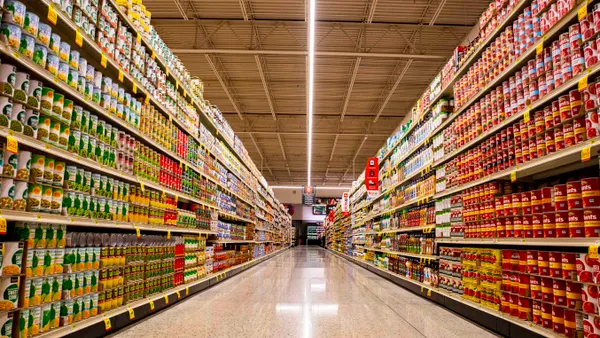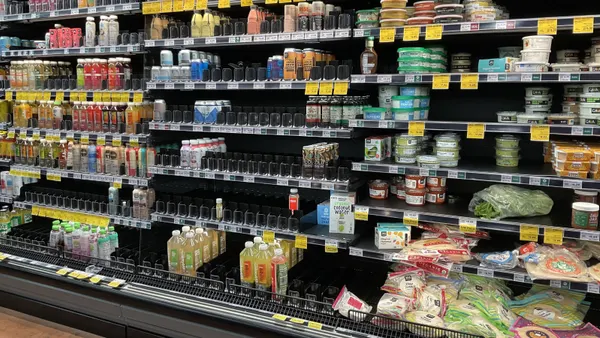Dive Brief:
- Nestlé will transition from direct-store delivery (DSD) to a warehouse model beginning in the third quarter of 2019. It is expected to complete the process by the second quarter of 2020.
- The company will leverage its already-existing warehouse network for frozen meals and snacks. The switch will result in shuttering eight frozen distribution centers and inventory transfer points.
- "Ice Cream and Pizza are growing categories in which we hold strong leadership positions," Steve Presley, chairman and CEO of Nestlé USA, said in a written statement. "As we continue to focus on driving long-term profitable growth, leveraging a simpler route to market unlocks resources we can use to fuel our efforts in demand generation, such as product innovation and brand building."
Dive Insight:
In a world where the Amazon effect has turned retail on its head, manufacturers are left racing to meet consumer demand where the consumer is. As a result, DSD is a model that is falling by the wayside.
A decade ago, DSD was touted as the ideal way to sell exactly what the customer wants with the freshest products in the store. Merchandisers went into stores, looked at the inventory levels on shelves, and refilled them from their respective companies' warehouses. The model relies on the assumption that consumers are shopping in-store. It also requires extra labor, like merchandisers, as well as significant assets like delivery trucks.
In the warehouse model, the middle man is cut out. Products are shipped directly to supermarket warehouses, and stores can stock their own shelves accordingly. One advantage of this is cost savings, but it also assists manufacturers with control. The warehouse model allows manufacturers to more accurately gauge total consumer demand and stock inventory accordingly.
At the same time, a warehouse model is not a perfect solution. Out-of-stock items will take longer to get to shelves because they have to come directly from the manufacturer instead of a merchandiser going to his own warehouse to restock. Similarly, manufacturers like Nestlé will need to rely on retailers to have warehouses that are equipped with facilities to store fresh or frozen products to avoid spoilage.
Since Nestlé is making the move away from DSD in the frozen pizza and ice cream category, it is clearly confident that retailers are prepared to store the products. The company already uses a warehouse model for its frozen and snacks segments, which likely need similar equipment.
At the same time, it makes sense for Nestlé to change the delivery for these two products. As consumers look for easier dinner options and seek indulgences in their increasingly busy lives, the frozen segment has continued to grow. By changing the model, prices are likely to come down for the consumer and make Nestlé’s products more competitive. Depending on the success of this switch, it wouldn’t be surprising to see the Swiss company move in this direction for other segments, especially as it looks to grow. The biggest advantage of leaving merchandising to supermarkets is that Nestlé can spend its energies elsewhere, focusing on perhaps direct-to-consumer delivery.
Still, a warehouse model is not a fail-proof solution. When Kellogg made the switch in 2017, the company noted that the transition would negatively affect net sales and gross margin in 2017 and 2018. Last May, Kellogg finally reported a benefit of the change: 9% to 11% adjusted EPS growth, largely due to savings from its DSD transition.
The cereal giant also closed some of its distribution centers and put 1,100 people out of work. Nestlé will dismiss about 4,000 workers with the closure of its facilities, according to Bloomberg. While fewer salaries to pay will mean some extra ready cash at hand, Nestlé will need to watch out that the shuttering of the facilities doesn’t play out like it did for Kellogg, whose distributors demanded compensation for terminated contracts.
Morningstar Equity Research had a mixed view of the move, according to an analyst note written by Ioannis Pontikis emailed to Food Dive. While he supports the move in general and applauded the impact it would have on margins, he noted it may have residual consequences. Even if unit sales are up, price reduction would likely take sales figures on the whole down. Restructuring costs related to the change could run Nestlé $500 million — but could also have non-monetary costs.
"As distribution is given away to retailers, one could argue that a portion of Nestlé's competitive advantage (versus competitors with no distribution capabilities) weakens, which could negatively affect volumes," the note states.
While the cost savings of a warehouse model may look good on paper, Nestlé should be wary of cutting costs in distribution solely to give it an edge.












